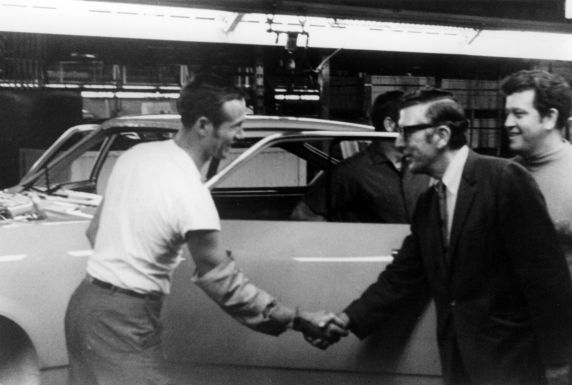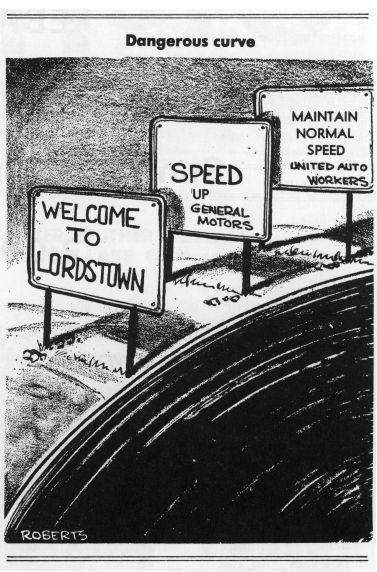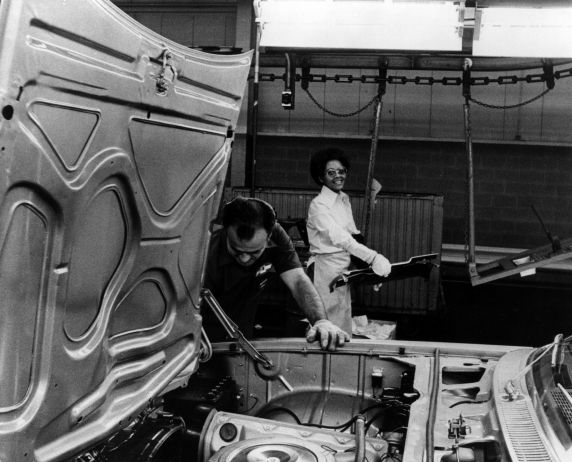The 1972 Lordstown Strike
Work speed-ups on the line helped to initiate the 1972 strike at a General Motors assembly plant in Lordstown, Ohio. Although the strike’s impact was initially felt at GM, its influence quickly grew, informing the nation about the struggles of its young workforce, and influencing the content of congressional hearings and national studies.
The General Motors' Lordstown, Ohio assembly plant was built in 1966 with modern technologies enabling more automation and promising new efficiencies. Originally, Lordstown was divided into two separate divisions, Chevrolet and Fisher Body. By 1971 when Chevrolet introduced its new car, the Vega, the two employee divisions were consolidated under the General Motors Assembly Division (GMAD) or “Get Mean And Destroy,” as David Poole, Recording Secretary for UAW Local 1112, which represented over 8,000 Lordstown employees, wrote in the Local’s paper, See Here.
The amalgamation of these two divisions naturally created workforce duplication, providing GMAD with an opportunity to cut jobs, saving money and maximizing efficiencies. As pointed out by then Local 1112 President Gary Bryner, in an October 4th, 1971 article in Cleveland’s The Plain Dealer: “They naturally save management money because they don’t have the need for two plant managers, they have one; they don’t have two personnel departments, they have one; they don’t have 14 shop committeemen, they have seven.”
Despite reducing the workforce, Lordstown’s promised efficiencies were still demanded by GMAD. Rather than assembling 55 vehicles per hour as was typical of most plants at the time, Lordstown workers were expected to turn out 100 per hour as promised by the plant's modern technologies. After the GMAD workforce reductions, this equated to each worker having only 36 seconds to complete work, rather than the standard 60. The speed-up resulted in the promised 100 vehicles coming off the line, but in various states of completion. Management accused workers of sabotage. While Local 1112 admitted this was true in a very few number of cases, the union insisted the real issues were management’s imposed speed-ups and cuts in workforce. As incomplete and damaged cars and trucks continued to roll off the line, GMAD claimed workers were intentionally slowing down their efforts and filed discipline charges against workers. Conversely, workers argued that their jobs required speed beyond human capabilities and filed grievances against GMAD.
An additional factor was the demographic composition of Lordstown’s workers, and how the relatively young workforce affected union demands. Local 1112’s President was a mere 29 years old, and the average age of a worker on the Lordstown line was 24. As noted in Akron’s Beacon Journal, “these workers reflect the changing life style of today’s youth. Many wear their hair shoulder length, have grown mustaches or beards and come to work in hip-hugging, bell-bottomed trousers. They are probably better educated than any generation of workers in the history of American industry. They were taught to question traditional values and encouraged to stand up and be counted.”
The workers did stand up and question the new standards and regulations implemented by GMAD. Tensions escalated during the 1971 December holidays, as workers were sent home early on numerous occasions, resulting in lost wages. Although talks were underway to take the two existing division’s contracts and merge them into the GMAD, by mid-January 1972, Local 1112 officials were discussing the timing of a likely strike authorization vote.
On March 3, 1972, Lordstown authorized a strike. Throughout the strike, difficulties for the workers continued, including problems obtaining Supplemental Unemployment Benefits (SUBs) which provide employees a percentage of their salaries during times of layoff or strike. However, by the end of the month, a settlement, although not one that could be hailed as a victory for either side, was reached. As described in the March 26, 1972 Special Membership Meeting minutes, the Local “kept everything we had, and made a few limited expansions in some areas.” The gains won by Local 1112 essentially returned the plant to its pre-GMAD state, including the elimination of the line speed-ups.
 UAW President Leonard Woodcock shakes hands with one of the assembly line workers at the Lordstown, Ohio assembly plant.
UAW President Leonard Woodcock shakes hands with one of the assembly line workers at the Lordstown, Ohio assembly plant.
By strike’s end, the New York Times reported that the strike cost GM about $150 million in lost sales. The strike and associated struggle spawned “Lordstown syndrome,” as it was called in Business Week, referring to the plant’s youthful workers who “rebel against assembly-line woes.” Perhaps the most important effect of the Lordstown strike was the broadened awareness of the younger union worker’s plight, as summarized by an older Lordstown union official, “If you were 22 and had a job where you were treated like a machine and knew you had about 30 years to go, how would you feel?”
The Lordstown strike’s lasting effects went well beyond the boundaries of the plant and Local 1112. Lordstown helped to initiate discussions and action at the federal level, including Senate hearings, Ted Kennedy's introduction of the "Worker Alienation Research and Technical Assistance Act of 1972" (it did not pass), and the creation of a national commission to study worker issues such as job satisfaction. Jefferson Cowie's book, Staying Alive, asserts that the commission's report, Work in America, in conjunction with the Lordstown strike, helped to launch the "‘quality of work life’ movement" whose mission focused on the larger issues seen at Lordstown like the implementation of automation and a goal "to redesign work" to make jobs less robotic and more engaging and gratifying for the worker.
While the strike may not have gained the Lordstown employees much more than their previous status quo, it did serve to inform the country of the new challenges facing union workers, as well as their changing needs. Lordstown ushered in change in America’s auto industry, where unions now fought for job satisfaction and “quality of work life” alongside issues such as salary and benefits.
For more information on the 1972 Lordstown Strike, see the following collections and publications:
UAW Local 1112 Records
Robert Guthridge Papers
Charles White Papers
UAW General Motors Department Papers
UAW President's Office: Leonard Woodcock Records
UAW Vice President's Office: Irving Bluestone Records
See Here
Solidarity
Alexandra Orchard is the Archivist for the Service Employees International Union (SEIU).
- aorchard's blog
- Login to post comments
- Printer-friendly version



 Reddit
Reddit Facebook
Facebook LinkedIn
LinkedIn